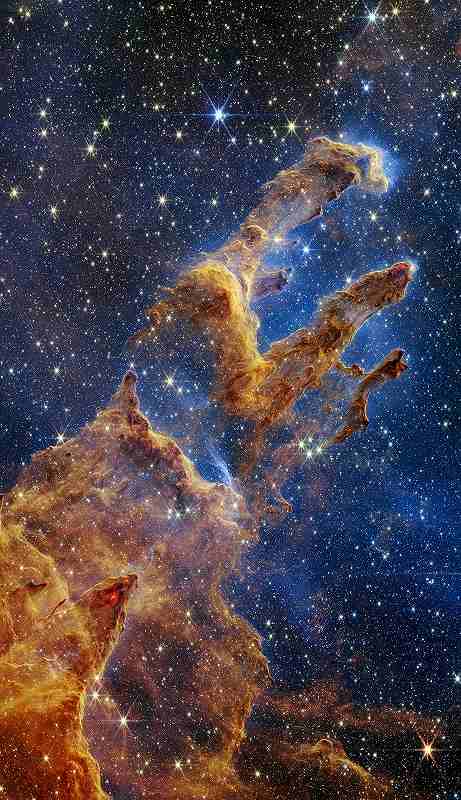
The Pillars of Creation that are set off in a kaleidoscope of color in NASA’s James Webb Space Telescope’s near-infrared-light view are seen in this photo provided by NASA on Oct. 19.
16:40 JST, October 28, 2022
WASHINGTON (AFP-Jiji) — The James Webb Space Telescope captured the iconic “Pillars of Creation,” huge structures of gas and dust teeming with stars, NASA said Oct. 19, and the image is as majestic as one could hope.
The twinkling of thousands of stars illuminates the telescope’s first shot of the gigantic gold, copper and brown columns standing in the midst of the cosmos.
At the ends of several pillars are bright red, lava-like spots. “These are ejections from stars that are still forming,” only a few hundred thousand years old, NASA said in a statement.
These “young stars periodically shoot out supersonic jets that collide with clouds of material, like these thick pillars,” the U.S. space agency added.
The “Pillars of Creation” are located 6,500 light years from Earth, in the Eagle Nebula of our Milky Way galaxy.
The pillars were made famous by the Hubble Space Telescope, which first captured them in 1995 and then again in 2014.
But thanks to Webb’s infrared capabilities, the newer telescope — launched into space less than a year ago — can peer through the opacity of the pillars, revealing many new stars forming.
“By popular demand, we had to do the Pillars of Creation” with Webb, Klaus Pontoppidan, the science program manager at the Space Telescope Science Institute, said Oct. 19 on Twitter.
STScI operates Webb from Baltimore, Md.
“There are just so many stars!” Pontoppidan added.
NASA astrophysicist Amber Straughn summed it up: “The universe is beautiful!” she wrote on Twitter.
The image, covering an area of about eight light years, was taken by Webb’s primary imager NIRCam, which captures near-infrared wavelengths — invisible to the human eye.
The colors of the image have been “translated” into visible light.
According to NASA, the new image “will help researchers revamp their models of star formation by identifying far more precise counts of newly formed stars, along with the quantities of gas and dust in the region.”
Operational since July, Webb is the most powerful space telescope ever built, and has already unleashed a raft of unprecedented data. Scientists are hopeful it will herald a new era of discovery. One of the main goals for the $10-billion telescope is to study the life cycle of stars. Another main research focus is on exoplanets, planets outside Earth’s solar system.
"Science & Nature" POPULAR ARTICLE
-

Genome Study Reveals Milestone in History of Cat Domestication
-

Big Leap in Quest to Get to Bottom of Climate Ice Mystery
-

Security Camera Footage Vulnerable to Outside Access; Investigation Finds 3,000 Pieces Exposed Online
-

Paws on Parade: Nairobi’s Dogs Dazzle at ‘Pawchella’
-

Japanese Eels Escape New Regulation in Vote at CITES Meeting, Avoiding Higher Prices for Dealers and Diners
JN ACCESS RANKING
-

Keidanren Chairman Yoshinobu Tsutsui Visits Kashiwazaki-Kariwa Nuclear Power Plant; Inspects New Emergency Safety System
-

Imports of Rare Earths from China Facing Delays, May Be Caused by Deterioration of Japan-China Relations
-

University of Tokyo Professor Discusses Japanese Economic Security in Interview Ahead of Forum
-

Japan Pulls out of Vietnam Nuclear Project, Complicating Hanoi’s Power Plans
-

Govt Aims to Expand NISA Program Lineup, Abolish Age Restriction






















